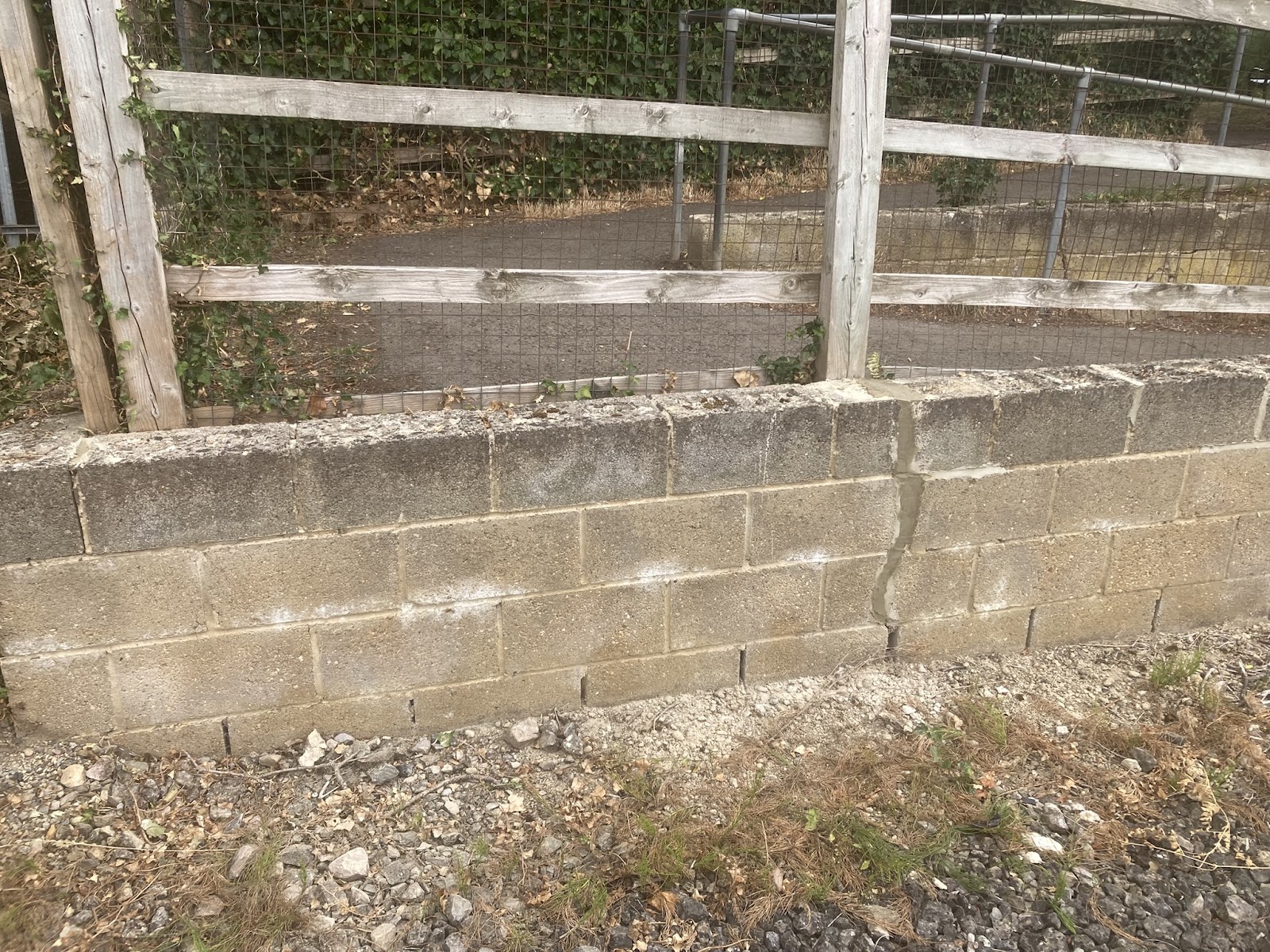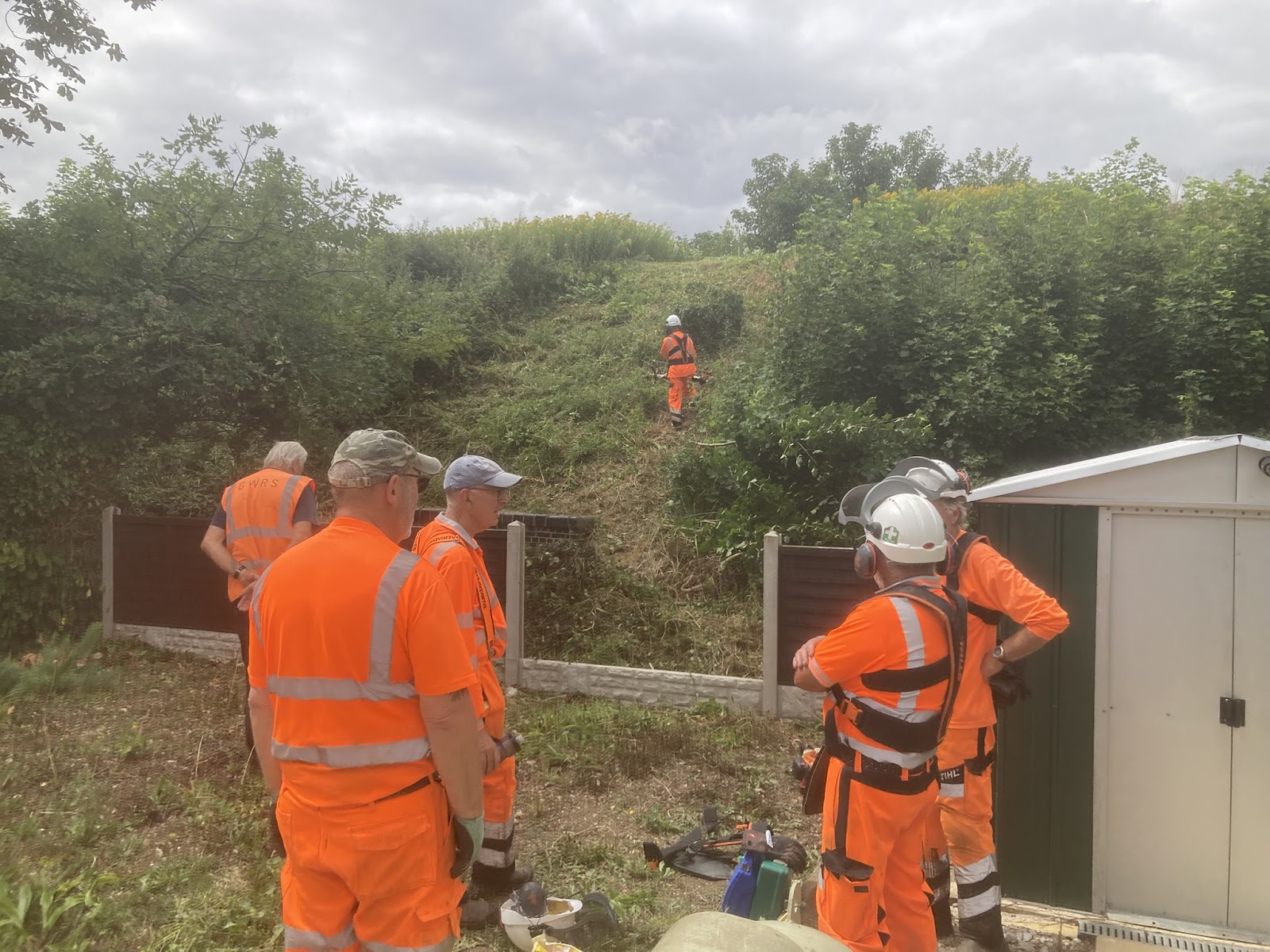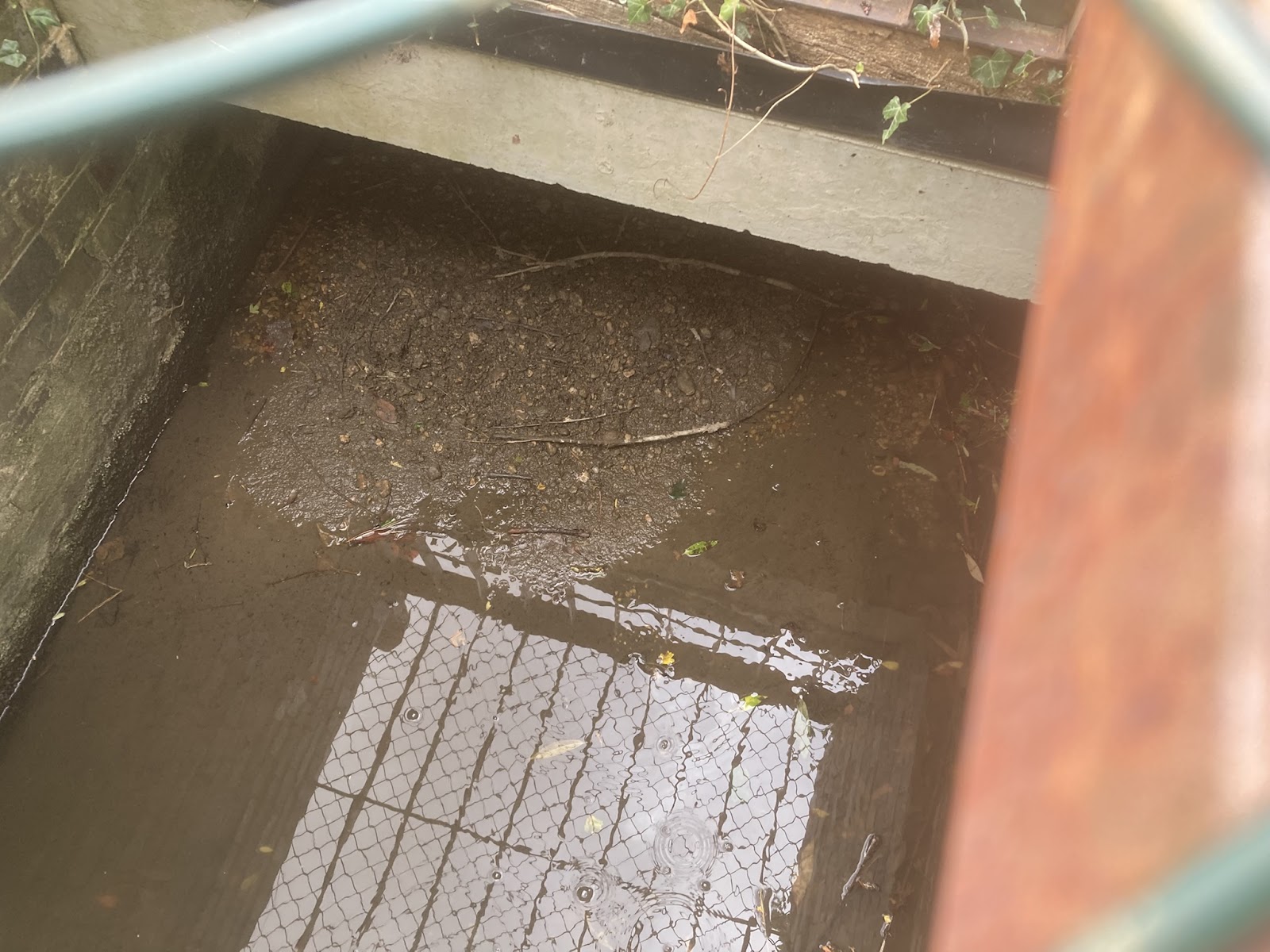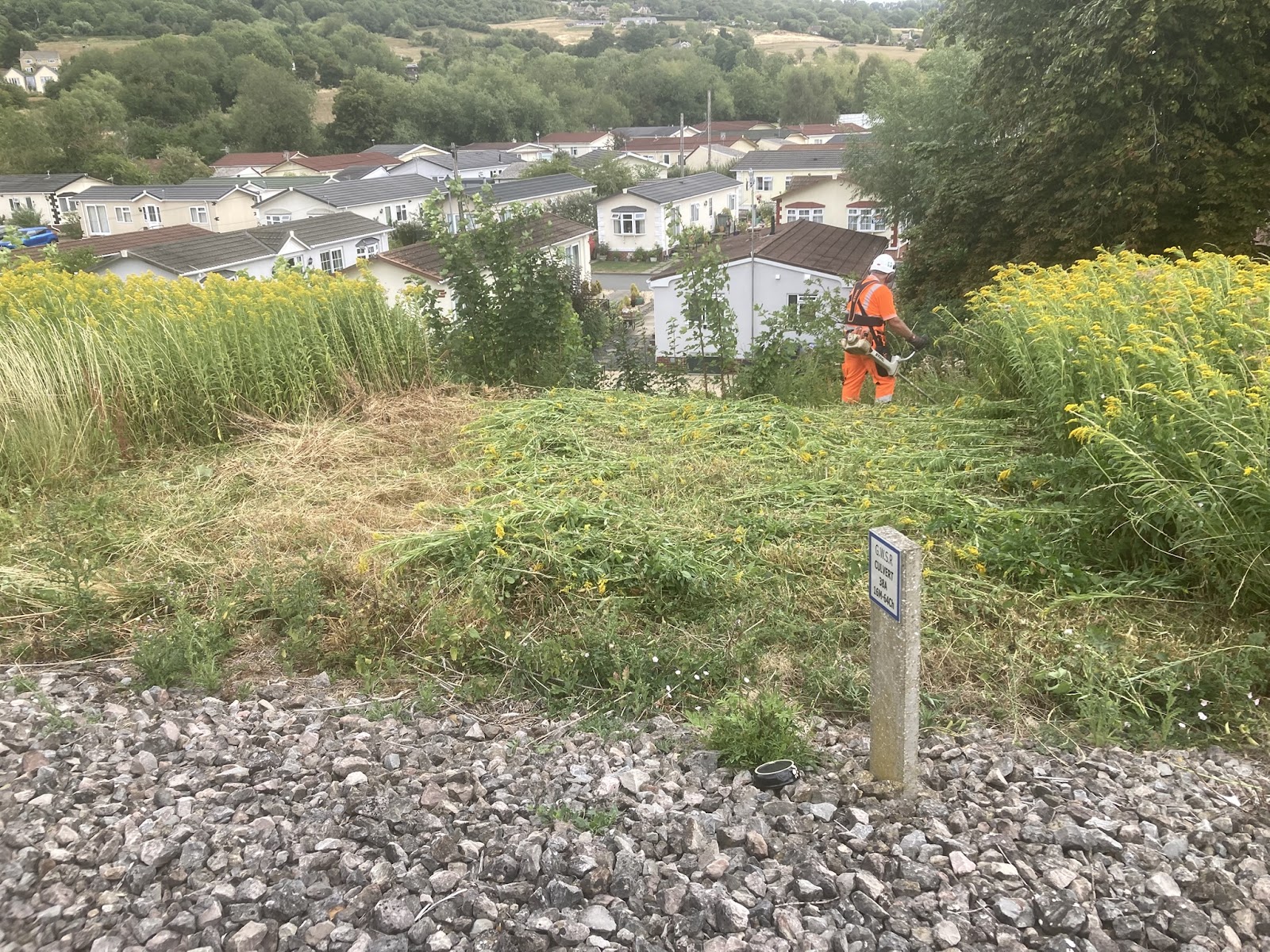Thursday 17th July
A return to a normal size work force of nine today.
Jonathan,
Polly and Peter travelled to Pecked Lane crossing at Bishops Cleeve.
The main task was to fit mesh over the grids
covering the down side entry of culvert 39A. This is to prevent some
anti social behaviour by
some users of the crossing who regularly toss filled dog poo bags
into the culvert.Wire mesh added on the top of the metal grids of culvert 39A inlet.
Whilst attending to this, they noted that just inside the down side entry, there is a large accumulation of silt which is causing the flow of water to enter the down side cess. Removing the metal inspection lid on the up side exit confirmed that no water is actually flowing through the culvert. To gain access to remove the silt will require removal of the metal grids on the down side inlet. We have provisionally planned for this next week.
 |
| The bar of silt is just visible immediately under the inlet entry on the down side of 38A. |
Whilst at Pecked Lane, they checked on three items on the defect register concerning fencing – one had already been rectified. Also Polly added more mortar to the cracks in the down side wall of the crossing approach ramp. Obviously the continuing dry weather is causing the ground to shrink further. Maybe some attention to this structure, combined with a facing of blue engineering bricks will be one of our future projects.
 |
| More repointing on Pecked Lane crossing down side access ramp. |
The
other six attendees (Roger, Ian, Andrew. Nigel, Dave, Martin) headed
to the Willow Drive mobile home park at Woodmancote. One of the
residents there had grated us permission to access the down side of
the line through his garden, even removing the larch lap panels from
his fence to facilitate this. This enabled us to safely and
comfortably access the inlet of culvert 38A and the toe ditch that
runs either side of it. This was like a jungle. First we
removed
a
large quantity of bramble and ivy covering the original fence line by
the resident’s garden. Dave and Nigel then proceeded in
the Cheltenham direction, clearing the toe ditch up to the point
where it ends.Dave and Nigel's handiwork on the high mileage end of the ditch. A month ago this was impenetrable. Clearing
the vegetation from the ditch reveals a lot of other debris, including
old concrete fence posts that will have to be removed later
 |
| In places the land outside the railway boundary has been raised, but the ditch is now undercutting that. Our current thoughts are to pipe some of the sections of this ditch. |
They also cleared around the down side headwall of culvert 38A. Ian and Roger headed in the opposite direction, clearing the ditch back to the point where our colleagues from Lineside Clearance had reached a few weeks ago. Meanwhile Martin and Andrew, our chain saw operators, tacked some of the larger branches around the stream.
 |
| Martin gets to grip with some of the thicker ivy. |
The continuing dry spell was a bonus, the 38A stream was just a trickle and the toe ditch was just damp in places. However the hot humid weather made for uncomfortable work whilst wearing full brush cutting or chain sawing PPE. Fortunately for most of the day the sun was not shining.
 |
| In this hot weather, frequent breaks are essential. (L to R: Ian, Roger, Martin, Nigel, Dave) |
Jonathan,
Polly and Peter joined
the team at Willow Drive at lunchtime. They
loaded the tipper
transit with the larger items of debris, tree trunks, fence posts and
rails and several lengths of wire from the original GWR post and wire
fencing. Broken wire is a hazard to brush cutters. Finally we cleared
the area on the down side embankment above the culvert bore. This
prevents any roots from vegetation penetrating the brick arch.
Special
mention to Roger and Ian who skilfully handled brush cutters on this
very steep embankment.Roger clearing from the trackside down the embankment - immediately prior to discovering the wasps nest.
 |
| Ian clearing up the embankment, watched by others in the group from the resident's garden. |
 |
| The original line of the boundary fence is apparent from the remaining GWR post now at angle. |
At the end of the day, the transformation was very noticeable. However, we will need some further visits here to fully mulch the vegetation we cut today; to remove some more large branches and saplings; also to clear some obstructions in the toe ditch on the low mileage side of the culvert and to clear along the boundary fence line up to Station Road Bridge. Also back towards the exit of cross drain 37G near footpath underbridge 38 is another length of toe ditch requiring vegetation cutting. This will have to wait until a treated patch of Japanese Knot Weed has finally died off and the contaminated stems removed.
 |
| Near the 37G outlet the marked off section with treated Japanese Knot weed on the other side of the ditch |
 |
| End of day - looking in the low mileage direction from culvert 38A inlet. |
Wildlife report: As ever at Bishops Cleeve, some of the resident black headed gulls were noted circling over head at lunchtime. A lone red kite swooped low over the embankment, obviously spotting some small mammals we have disturbed. In the ditch we noted several large dragonflies – but less welcome were some angry wasps who are nesting on the embankment. Our helpful resident informed us that there is a family of foxes living under an empty home of the site; and he often spots a lone badger in the same spot.





Even on a line of 'only' 14 miles in length, there's still a lot of work to be done to maintain all the drainage along it! Thanks for taking the time and energy to prepare this update!
ReplyDeletejnc - yes, quite correct 14 miles of track is enough for the current team strength.
DeleteRegarding the undercutting of the raised land within the mobile home park, could a gentle request be put forward to the owners of the site to at least help towards the significant cost of piping this water course. In turn, it would be a long term benefit to them and their residents. Piping would also be a benefit to the lineside clearance team as the flail would be able to access the bottom of the embankment, possibly.
ReplyDeleteThe other more important long term benefit to the railway as a whole, would be to stabilize the toe of the embankment where, in places such as the photo with GWR fence post at an angle, it is bulking at its juncture to the ditch. An expensive project I agree, but if started at the point of culvert 38A and working northwards back to culvert 37G, it could be piped in stages starting with the most important section. One point though, having witnessed the volumes of water that on the rare occasion flows through this ditch, a 450mm pipe would have to be the minimum.
Andy - yes the next task there is to measure the width and depth of the ditch to see what size of pipe we can fit in. We do have some spare lengths of 600mm id twinwall. The challenge with that is getting it to site. Like our work at a few other sites, this long dry spell is making things a lot easier for us!
Delete